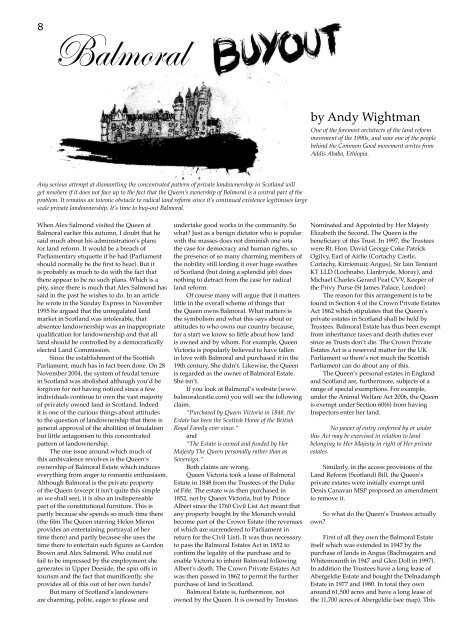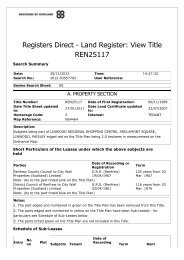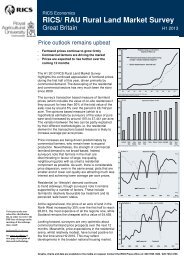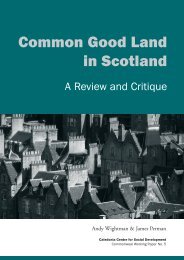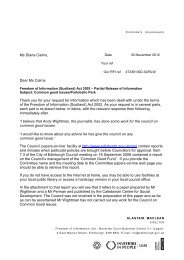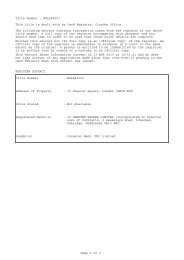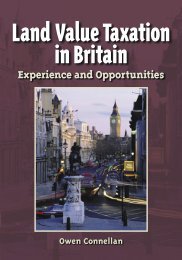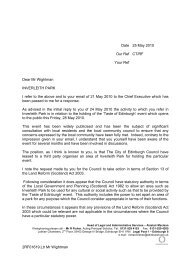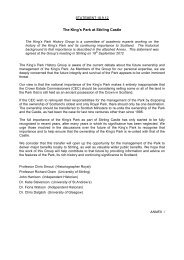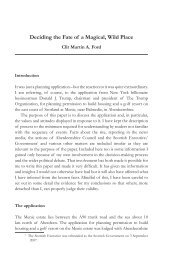Balmoral - Land Matters
Balmoral - Land Matters
Balmoral - Land Matters
You also want an ePaper? Increase the reach of your titles
YUMPU automatically turns print PDFs into web optimized ePapers that Google loves.
8<br />
<strong>Balmoral</strong><br />
Any serious attempt at dismantling the concentrated pattern of private landownership in Scotland will<br />
get nowhere if it does not face up to the fact that the Queen’s ownership of <strong>Balmoral</strong> is a central part of the<br />
problem. It remains an totemic obstacle to radical land reform since it’s continued existence legitimises large<br />
scale private landownership. It’s time to buy-out <strong>Balmoral</strong>.<br />
When Alex Salmond visited the Queen at<br />
<strong>Balmoral</strong> earlier this autumn, I doubt that he<br />
said much about his administration’s plans<br />
for land reform. It would be a breach of<br />
Parliamentary etiquette if he had (Parliament<br />
should normally be the first to hear). But it<br />
is probably as much to do with the fact that<br />
there appear to be no such plans. Which is a<br />
pity, since there is much that Alex Salmond has<br />
said in the past he wishes to do. In an article<br />
he wrote in the Sunday Express in November<br />
1995 he argued that the unregulated land<br />
market in Scotland was intolerable, that<br />
absentee landownership was an inappropriate<br />
qualification for landownership and that all<br />
land should be controlled by a democratically<br />
elected <strong>Land</strong> Commission.<br />
Since the establishment of the Scottish<br />
Parliament, much has in fact been done. On 28<br />
November 2004, the system of feudal tenure<br />
in Scotland was abolished although you’d be<br />
forgiven for not having noticed since a few<br />
individuals continue to own the vast majority<br />
of privately owned land in Scotland. Indeed<br />
it is one of the curious things about attitudes<br />
to the question of landownership that there is<br />
general approval of the abolition of feudalism<br />
but little antagonism to this concentrated<br />
pattern of landownership.<br />
The one issue around which much of<br />
this ambivalence revolves is the Queen’s<br />
ownership of <strong>Balmoral</strong> Estate which induces<br />
everything from anger to romantic enthusiasm.<br />
Although <strong>Balmoral</strong> is the private property<br />
of the Queen (except it isn’t quite this simple<br />
as we shall see), it is also an indispensable<br />
part of the constitutional furniture. This is<br />
partly because she spends so much time there<br />
(the film The Queen starring Helen Mirren<br />
provides an entertaining portrayal of her<br />
time there) and partly because she uses the<br />
time there to entertain such figures as Gordon<br />
Brown and Alex Salmond. Who could not<br />
fail to be impressed by the employment she<br />
generates in Upper Deeside, the spin offs in<br />
tourism and the fact that munificently, she<br />
provides all of this out of her own funds?<br />
But many of Scotland’s landowners<br />
are charming, polite, eager to please and<br />
undertake good works in the community. So<br />
what? Just as a benign dictator who is popular<br />
with the masses does not diminish one iota<br />
the case for democracy and human rights, so<br />
the presence of so many charming members of<br />
the nobility still lording it over huge swathes<br />
of Scotland (but doing a splendid job) does<br />
nothing to detract from the case for radical<br />
land reform.<br />
Of course many will argue that it matters<br />
little in the overall scheme of things that<br />
the Queen owns <strong>Balmoral</strong>. What matters is<br />
the symbolism and what this says about or<br />
attitudes to who owns our country because,<br />
for a start we know so little about how land<br />
is owned and by whom. For example, Queen<br />
Victoria is popularly believed to have fallen<br />
in love with <strong>Balmoral</strong> and purchased it in the<br />
19th century. She didn’t. Likewise, the Queen<br />
is regarded as the owner of <strong>Balmoral</strong> Estate.<br />
She isn’t.<br />
If you look at <strong>Balmoral</strong>’s website (www.<br />
balmoralcastle.com) you will see the following<br />
claim.<br />
“Purchased by Queen Victoria in 1848, the<br />
Estate has been the Scottish Home of the British<br />
Royal Family ever since.”<br />
and<br />
“The Estate is owned and funded by Her<br />
Majesty The Queen personally rather than as<br />
Sovereign.”<br />
Both claims are wrong.<br />
Queen Victoria took a lease of <strong>Balmoral</strong><br />
Estate in 1848 from the Trustees of the Duke<br />
of Fife. The estate was then purchased in<br />
1852, not by Queen Victoria, but by Prince<br />
Albert since the 1760 Civil List Act meant that<br />
any property bought by the Monarch would<br />
become part of the Crown Estate (the revenues<br />
of which are surrendered to Parliament in<br />
return for the Civil List). It was thus necessary<br />
to pass the <strong>Balmoral</strong> Estates Act in 1852 to<br />
confirm the legality of the purchase and to<br />
enable Victoria to inherit <strong>Balmoral</strong> following<br />
Albert’s death. The Crown Private Estates Act<br />
was then passed in 1862 to permit the further<br />
purchase of land in Scotland.<br />
<strong>Balmoral</strong> Estate is, furthermore, not<br />
owned by the Queen. It is owned by Trustees<br />
by Andy Wightman<br />
One of the foremost architects of the land reform<br />
movement of the 1990s, and now one of the people<br />
behind the Common Good movement writes from<br />
Addis Ababa, Ethiopia.<br />
Nominated and Appointed by Her Majesty<br />
Elizabeth the Second. The Queen is the<br />
beneficiary of this Trust. In 1997, the Trustees<br />
were Rt. Hon. David George Coke Patrick<br />
Ogilvy, Earl of Airlie (Cortachy Castle,<br />
Cortachy, Kirriemuir, Angus), Sir Iain Tennant<br />
KT LLD (Lochnabo, Llanbryde, Moray), and<br />
Michael Charles Gerard Peat CVV, Keeper of<br />
the Privy Purse (St James Palace, London)<br />
The reason for this arrangement is to be<br />
found in Section 4 of the Crown Private Estates<br />
Act 1862 which stipulates that the Queen’s<br />
private estates in Scotland shall be held by<br />
Trustees. <strong>Balmoral</strong> Estate has thus been exempt<br />
from inheritance taxes and death duties ever<br />
since as Trusts don’t die. The Crown Private<br />
Estates Act is a reserved matter for the UK<br />
Parliament so there’s not much the Scottish<br />
Parliament can do about any of this.<br />
The Queen’s personal estates in England<br />
and Scotland are, furthermore, subjects of a<br />
range of special exemptions. For example,<br />
under the Animal Welfare Act 2006, the Queen<br />
is exempt under Section 60(6) from having<br />
Inspectors enter her land.<br />
No power of entry conferred by or under<br />
this Act may be exercised in relation to land<br />
belonging to Her Majesty in right of Her private<br />
estates.<br />
Similarly, in the access provisions of the<br />
<strong>Land</strong> Reform (Scotland) Bill, the Queen’s<br />
private estates were initially exempt until<br />
Denis Canavan MSP proposed an amendment<br />
to remove it.<br />
So what do the Queen’s Trustees actually<br />
own?<br />
First of all they own the <strong>Balmoral</strong> Estate<br />
itself which was extended in 1947 by the<br />
purchase of lands in Angus (Bachnagairn and<br />
Whitemounth in 1947 and Glen Doll in 1997).<br />
In addition the Trustees have a long lease of<br />
Abergeldie Estate and bought the Delnadamph<br />
Estate in 1977 and 1980. In total they own<br />
around 61,500 acres and have a long lease of<br />
the 11,700 acres of Abergeldie (see map). This
S tarting with the Queen..... Her late mother was the daughter of the 14th<br />
Earl of Strathmore. He was married to Cecilia Cavendish-Bentinck<br />
and the Queen Mother’s older sister was married to the 4th Earl of<br />
Granville whose grandfather was the infamous first Duke of Sutherland. The 2nd Earl of<br />
Granville’s daughter was the grandmother of James Morrison, Lord Margadale. Princess<br />
Antonia von Preusen, another relative of the Queen is married to the Marquess of Duoro<br />
whose father is the 8th Duke of Wellington. The Lord Lieutenant of Aberdeenshire<br />
is Angus Farquharson of Finzean and prominent landowners who have have been<br />
appointed by the Queen across Scotland include the 12th Duke of Argyll, Major Alexander<br />
Trotter, 6th Marquess of Bute, 3rd Marquess of Linlithgow, Sir Iain Tennant (also Trustee<br />
of the Queen’s <strong>Balmoral</strong> estates), Alexander Melville, Earl of Leven, Sir David Butter,<br />
7th Earl of Mansfield and Sir Roderick Stirling. The Queen’s former private secretary is<br />
Lord Charteris of Amisfield, whose daughter is married to Lord Pearson of Rannoch.<br />
Lord Charteris’s brother is the 12th Earl of Wemyss and March, whose daughter, Lady<br />
Elizabeth Charteris is married to David Holford Benson, Chairman of Kleinwort Charter<br />
Investment Trust. A former Chairman of Kleinwort Benson Group (1993-96) itself is Baron<br />
Rockley who is married to the elder daughter of 7th Earl of Cadogan. The Queen is also<br />
related to the late Earl of Airlie through his brother, Sir Angus Ogilvy who is married to<br />
Princess Alexandra of Kent. The Countess of Airlie is also a Lady to the Bedchamber of<br />
the Queen. The Earl of Airlie was a Trustee of the Queen’s <strong>Balmoral</strong> estates and Chairman<br />
of Schroders, the merchant bank from 1977 to 1984 whilst Bruno Schroder himself owns<br />
Dunlossit Estate on Islay next door to Lord Margadale! Another relative of the Queen,<br />
James Hamilton, the 5th Duke of Abercorn is married to Alexandra Anastasia, whose niece<br />
is married to the Duke of Westminster. The Duke’s sister, Lady Jane Grosvenor, was the<br />
first wife of the Duke of Roxburghe. (Her marriage to Roxburghe made her the daughter<br />
of a Duke, the sister of a Duke, the wife of a Duke and finally the mother of a future<br />
Duke!). Meanwhile the Queen’s aunt, the Duchess of Gloucester, is the 3rd daughter of the<br />
7th Duke of Buccleuch whose widow is the daughter of the 13th Earl of Home (33,000).<br />
The current Duke of Buccleuch’s aunt is the Duchess of Northumberland (5000) whose<br />
daughter was the first wife of the Duke of Sutherland. The Duke of Buccleuch (Richard<br />
Walter John Montague Douglas Scott) is married to Lady Elizabeth Kerr, the youngest<br />
daughter of the 12th Marquess of Lothian (17,000). Lady Elizabeth’s sister, Lady Cecil Kerr,<br />
These people own over 12% of the privately-owned rural land in Scotland!<br />
makes them the 25th largest private landowner<br />
in Scotland (up from 68th in 1970).<br />
Despite this, the Scottish public by and<br />
large continues to be seduced by nobility and to<br />
approve of the Monarchy. Politicians know this<br />
but what is conveniently forgotten by today’s<br />
political classes (who seem more intent on<br />
securing good headlines next day than tackling<br />
deep seated political issues), is that landowning<br />
in Scotland continues to be an institution<br />
dominated by a tiny number of people. In the<br />
Highlands and Islands for example fully half<br />
of the private land - over 3.6 million acres is<br />
owned by fewer than 100 landowners and<br />
three-quarters of it is owned by around 300.<br />
Such a pattern is remarkable in itself but<br />
what is even more astonishing is the way in<br />
which the landowning establishment itself is<br />
not merely a collection of random individuals<br />
but a tightly knit network of power and<br />
influence extending into the fields of politics<br />
and finance. The small numbers involved<br />
facilitate the operation of this network and its<br />
effectiveness which extend to the highest levels<br />
of British society (see Box).<br />
This pattern of influence and landed<br />
power has lasted right up until the very end of<br />
the 20th century bolstered by wider networks<br />
within politics, finance and the law. Such<br />
intimate relationships promote social cohesion<br />
among landowners which makes them readily<br />
distinguishable today as a discrete class with<br />
its own values, internal networks, and related<br />
social institutions.<br />
Private landownership in Scotland remains<br />
a small, interrelated and privileged club which<br />
is proud to have the Queen as a member. But<br />
with land reform such an important part of<br />
public policy, what message does it send out<br />
when the Queen continues to play the role of<br />
Highland Laird? The Queen is supposed to<br />
set an example. In Scotland, public policy on<br />
land reform is to secure a “rapid change in<br />
the pattern of land ownership”. The Queen is<br />
running counter to that by being the owner of a<br />
large and expanding estate.<br />
The Queen, who, like other large<br />
landowners, owns estates to provide her with<br />
a place to spend her holidays can continue<br />
to enjoy her holidays as others do by renting<br />
a castle or country hotel. Under state or<br />
community ownership, the Queen could even<br />
continue to enjoy holidays at <strong>Balmoral</strong> if she<br />
wished<br />
To counter such suggestions and to<br />
is married to Donald Cameron of Locheil (younger) (76,881) (also the Lord Lieutenant<br />
of Inverness-shire). The hereditary master of the Queen’s household in Scotland is Ian<br />
Campbell, the 12th Duke of Argyll who is married to the daughter of Sir Ivar Colquhoun<br />
of Luss (37,191) whose nephew is Sir Michael Wigan (22,393). Sir Ivar’s sister is the widow<br />
of the 8th Earl of Arran. The great-grandson of the 4th Earl of Arran’s brother married<br />
the daughter of the 4th Earl of Cawdor (56,800). Going back to Donald Cameron for a<br />
minute - his grandmother was the daughter of the 5th Duke of Montrose (8800) whose<br />
son, the 6th Duke, was the father of Lady Jean Fforde, the mother of Charles Fforde from<br />
Arran (16,300). The 6th Duke’s niece married the late Thomas Campbell-Preston whose<br />
half-sister is Sarah Troughton (17,843). Thomas’s father, Robert Campbell-Preston was<br />
married to Angela Pearson, the 3rd daughter of 2nd Viscount Cowdray (76,600) and the<br />
mother (by her first marriage) of the late Duke of Atholl (148,000). The Atholl Estates<br />
factor, Andrew Gordon (11,100), is also the factor for Robin Fleming (92,141), whose<br />
cousin, Dorothy Fleming (who married his brother, Major Richard Fleming), together with<br />
her sister Mrs Schuster (And husband Richard Schuster, are also Argyllshire landowners<br />
(25418). Robert was chairman of Robert Fleming Holdings from 1990 - 1997 of which<br />
Henry Keswick is also a Director. Henry and his youngest brother Simon (26,003) are<br />
Chairman and Director of Jardine Matheson Holdings Ltd. (whose founder, James<br />
Matheson, at one time owned the Island of Lewis). At least six other Dumfriesshire<br />
landowners have close connections with Jardine Matheson. Henry is married to Tessa,<br />
Lady Reay, younger daughter of the late Lord Lovat whilst Henry’s other brother, Sir<br />
John “Chips” Keswick, Chairman of Hambro’s Bank, is married to Lady Sarah Ramsay,<br />
daughter of the 16th Earl of Dalhousie who himself is related to the Lovats through his<br />
wife whose mother was the daughter of the 13th Lord Lovat. The 16th Earl of Dalhousie’s<br />
cousin is the late Captain Ramsay of Mar and his late mother was Lady Mary Heathcote-<br />
Drummond-Willoughby, daughter of the 1st Earl of Ancaster. Her great niece is Baroness<br />
Jane Heathcote-Drummond-Willoughby de Eresby whose grandfather on her mother’s<br />
side was the 2nd Viscount Astor. The second son of the 1st Viscount Astor was the 1st<br />
Baron Astor of Hever whose grandson is Philip Astor. Philip’s sister, the Honourable Sarah<br />
Violet Astor is married to George Lopes. The first Baron Astor’s wife was the mother of the<br />
Marquess of <strong>Land</strong>sdowne and the daughter of the 4th Earl of Minto. The son and heir of<br />
the Marquess is the Earl of Shelbourne whose brother is Lord Robert Mercer-Nairne.<br />
9<br />
promote its role as a modern and progressive<br />
estate, <strong>Balmoral</strong> Estate makes much of its<br />
economic impact on the local economy and in a<br />
recent study it claimed that<br />
“employment impacts total approximately 340<br />
full-time equivalent jobs in Upper Deeside or 400<br />
full-time equivalent jobs in Aberdeenshire. These<br />
employment impacts generate household income<br />
of over £6 million per year in Upper Deeside or<br />
£7 million in Aberdeenshire. The 340 full-time<br />
equivalent jobs in Upper Deeside (including<br />
Aboyne) represent up to 20% of the area’s total<br />
employment.”<br />
The problem with these studies is that the<br />
figures, whilst appearing impressive, actually<br />
bear no evidential relationship to ownership by<br />
the Queen. Such impacts are no doubt partly a<br />
consequence of the royal connection but they<br />
could equally arise (or be different) under any<br />
alternative form of ownership since the assets<br />
of the area would remain the same and the<br />
royal history would still be there.<br />
Any serious attempt at dismantling the<br />
concentrated pattern of private landownership<br />
in Scotland will get nowhere if it does not<br />
face up to the fact that the Queen’s ownership<br />
of <strong>Balmoral</strong> is a central part of the self same<br />
problem. It remains an obstacle to radical
10<br />
land reform since it’s continued existence<br />
legitimises large scale private landownership.<br />
This is exacerbated by the fact that<br />
<strong>Balmoral</strong> will be inherited by Prince Charles<br />
as heir to the throne. Not only will he pay no<br />
inheritance tax (although the Queen’s estate<br />
is subject to inheritance tax, bequests from<br />
Sovereign to Sovereign are exempt for the<br />
rather bizarre and illogical reason given on<br />
the Monarchy website that,<br />
“This is because the Sovereign is unable to<br />
generate significant new wealth through earnings<br />
or business activities, and to recognise the<br />
requirement for the Monarchy to have a degree of<br />
financial independence.”<br />
Whilst increasing numbers of ordinary<br />
members of the public face 40% inheritance<br />
tax bills on their parents’ house (and quite<br />
rightly so), the Queen’s heir will not. And<br />
whereas many ordinary people will have<br />
to sell inherited assets to pay the bill, the<br />
argument is that the Sovereign does not<br />
generate enough wealth to do this. But Prince<br />
Charles (who would have to foot the bill were<br />
he to be liable) earned over £15 million last<br />
year from the Duchy of Cornwall.<br />
Moreover, when any normal family<br />
inherits property, each child will usually<br />
receive an equal share, the Sovereign is<br />
still subject to the laws of Primogeniture so<br />
Princess Anne, Prince Andrew and Prince<br />
Edward will inherit nothing of <strong>Balmoral</strong>. If<br />
they did, it would at least do something to<br />
break down the pattern of ownership.<br />
Any moves to change the pattern<br />
of ownership should not be regarded as<br />
an attack on the Queen personally (her<br />
attitudes about how to manage <strong>Balmoral</strong><br />
are as progressive as those of many modern<br />
landowners) but a challenge to the idea that<br />
Scotland can ever truly create a modern<br />
democracy when it’s land continues to be in<br />
the hands of so few people.<br />
By way of contrast to the regulatory<br />
regime surrounding landownership, in<br />
Inverness there are 50 civil servants spending<br />
around £1.5 million pounds regulating 17,000<br />
crofts whose influence extends individually<br />
to a few acres of bog and rock. Their ability<br />
to assign their croft, sub-let it, decroft it, split<br />
it, amalgamate it, even their competence to<br />
use it are governed with what some might<br />
argue is an inappropriate and outdated form<br />
of paternalism but which, nevertheless,<br />
recognises in principle that the regulation of<br />
occupancy is in the public interest.<br />
Remarkable then, isn’t it, that at the same<br />
time the 100 people who between them own<br />
over half of the entire Highlands and Islands<br />
of Scotland are subject to no regulation.<br />
There is no <strong>Land</strong>owners’ Commission, no<br />
consideration of local needs, of the best<br />
interests of the community, or of taking action<br />
against absentees.<br />
Endless paperwork can surround the<br />
assignation of the tenancy of a few acres<br />
Common Good <strong>Land</strong> in Scotland<br />
A Review and Critique<br />
by Andy Wightman and James Perman<br />
Commonweal Working Paper No 5<br />
Published by the Caledonia Centre for Social Development<br />
£10 inc p&p (UK only)<br />
of heath above Newtonmore whilst on the<br />
other side of Strathspey 40,000 acres of<br />
internationally important land in Glen Feshie<br />
are traded between strange people in the<br />
VIP lounge at Heathrow Airport with not so<br />
much as a cursory glance at any wider public<br />
interest.<br />
In 1999, something remarkable took<br />
place. The ownership of 26 iconic properties<br />
such as Edinburgh Castle, Stirling Castle,<br />
Linlithgow Palace, Holyrood Park,<br />
Arbroath Abbey and Dunfermline Palace<br />
were transferred by the Crown Estate<br />
Commissioners to the Secretary of State<br />
for Scotland (within a few months Scottish<br />
Ministers then took over ownership). Quite<br />
why this was done is not entirely clear but<br />
the symbolism was evident (despite there<br />
never having been any publicity about this<br />
extraordinary dowry to devolution). The<br />
Crown Estate Commissioners appeared<br />
to believe that such properties were more<br />
appropriately held by representatives of the<br />
Scottish people.<br />
<strong>Balmoral</strong> Estate is a block on land reform<br />
and for so long as it’s ownership remains<br />
unquestioned so too will the wider pattern of<br />
large scale unregulated private ownership.<br />
<strong>Balmoral</strong> is the personal property of the<br />
Queen rather than part of the Crown Estate<br />
but the time has come to end this peculiar<br />
situation which continues to stand in the way<br />
of meaningful land reform.<br />
This ground-breaking 66 page report on the state of common good land across Scotland reviews the status of the assets belonging to the inhabitants<br />
of the former burghs of Scotland.<br />
Order a copy of this report by emailing your order to George Clark:<br />
clark@srds.co.uk<br />
“This blog follows on from the book Unspeak, which analyses state-of-the-art rhetorical weaponry, from community<br />
through sound science and ethnic cleansing to the war on terror.” Daily at: http://unspeak.net/


